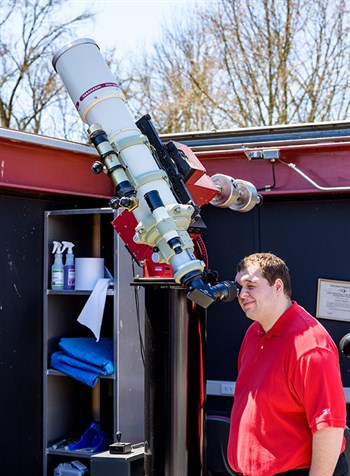Physics Student’s Achievements Astronomical

Space Explorer: Junior physics student Dylan Linville has worked with Herman A. Moench Distinguished Professor Richard Ditteon, the director of Rose-Hulman’s Oakley Observatory, on several astrophysics research projects on campus and in Australia.
Dylan Linville goes to great distances to explore new horizons in astronomy.
The junior physics student has utilized an optical reflecting telescope at Rose-Hulman’s Oakley Southern Sky Observatory in Australia, thousands of miles away from campus, to examine the size, shape and possible composition of asteroids that are scattered throughout the galaxy.
This fascination with astrophysics has taken Linville on a path of exploration that has resulted in his selection as a 2017 Goldwater Scholar, one of the nation’s most prestigious honors for undergraduate students majoring in the natural sciences, mathematics and engineering. He is among 240 scholars from 1,286 nominees chosen this year to receive one- and two-year scholarships to support the final year of undergraduate or first year of graduate studies.
Linville is the eighth Rose-Hulman student since 2008 to be honored by the Barry Goldwater Scholarship and Excellence in Education Foundation. (Mechanical engineering senior Ben Stevens was recognized in 2016.)
A Mentor, Ohio, native, Linville has contributed to research projects in asteroid photometry with Herman A. Moench Distinguished Professor Richard Ditteon, director of the Oakley Observatory, and in petroleum sulfur content analysis with physics and optical engineering professor Sudipa Kirtley. He co-authored an article published in The Minor Planet Bulletin, the national publication of the Association of Lunar and Planetary Observers, and will continue research in astrophysics this summer at the National Radio Astronomy Observatory in Green Bank, W.Va. He eventually hopes to become a college professor.
“I find space really interesting. There's so much out there and it's awe inspiring,” he says.
For instance, according to Linville, consider the Crab Nebula, a supernova remnant that’s nearly a thousand years old (and 6,523 light years away from Earth) after being formed by the explosion of a star hundreds times larger than the sun. Supernovas like the one that created the Crab Nebula, with their intense energy, contribute to produce such heavy elements as tin, iodine, gold, tungsten and xenon, including those on Earth. The distant Crab Nebula continues to captivate the interests of astronomy enthusiasts, young and old.
“There is a sense of wonder in studying space that I don't find anywhere else,” he says.
Linville is a member of the Rose-Hulman Astronomical Society and is taking an advanced observational astronomy course being taught for the first time on campus spring quarter. Last fall, he used photographs taken from the institute’s Australian-based observatory to measure five asteroids traveling across the southern hemisphere.
“I like to learn about things,” says Linville, who is striving to accentuate his physics degree with minors in astronomy and mathematics. “Doing original research is contributing to the global knowledge of science.”
Ditteon notes that Linville will be the lead author on a future paper of asteroid photometry research being collected this spring at the Oakley Observatory, and is a lead candidate for the Department of Physics and Optical Engineering’s Outstanding Astronomy Award for this academic year.
“Dylan is among the very best students who have been part of astronomy or astrophysics research at Rose-Hulman. He will be a great research scientist,” says Ditteon.